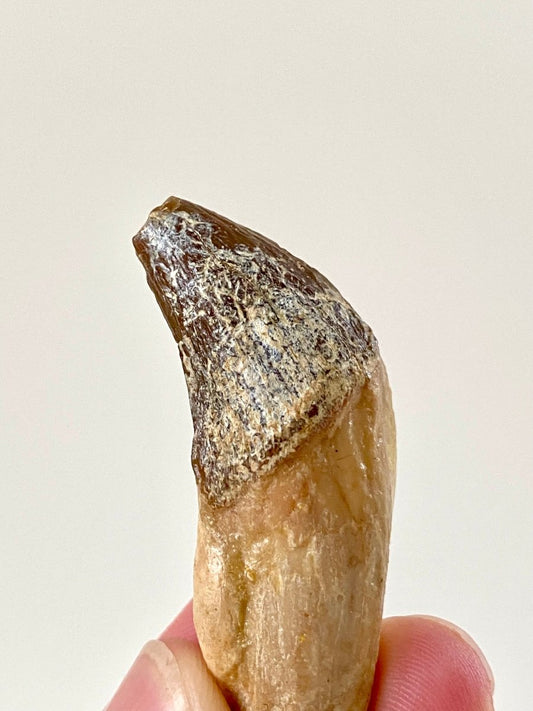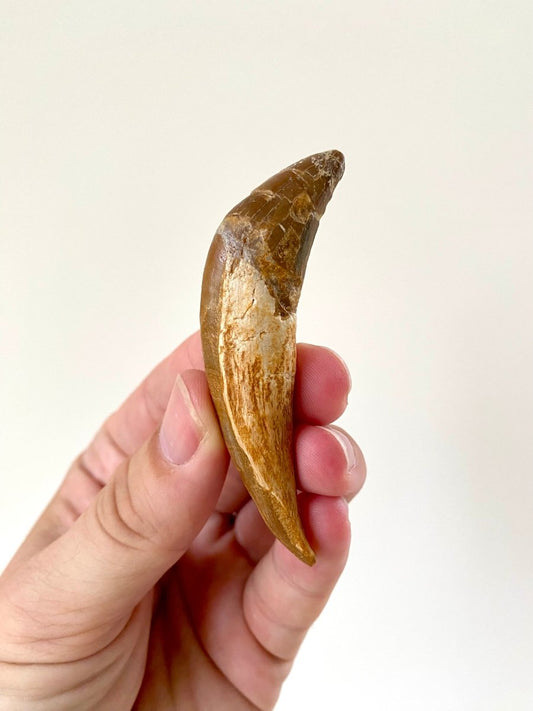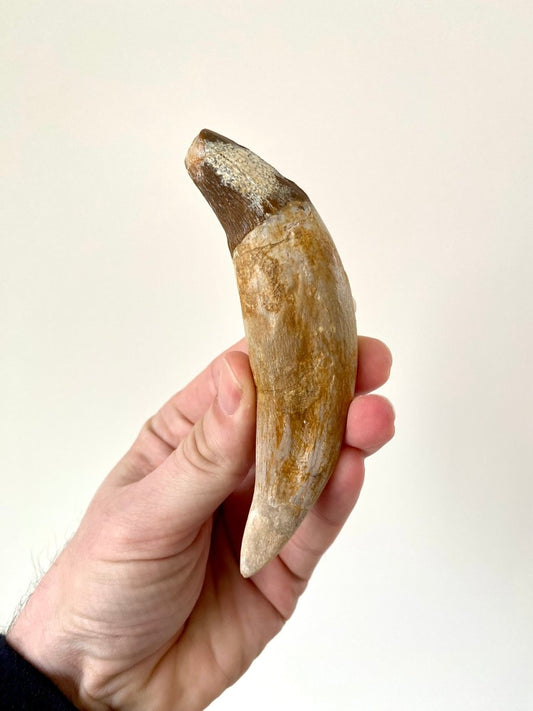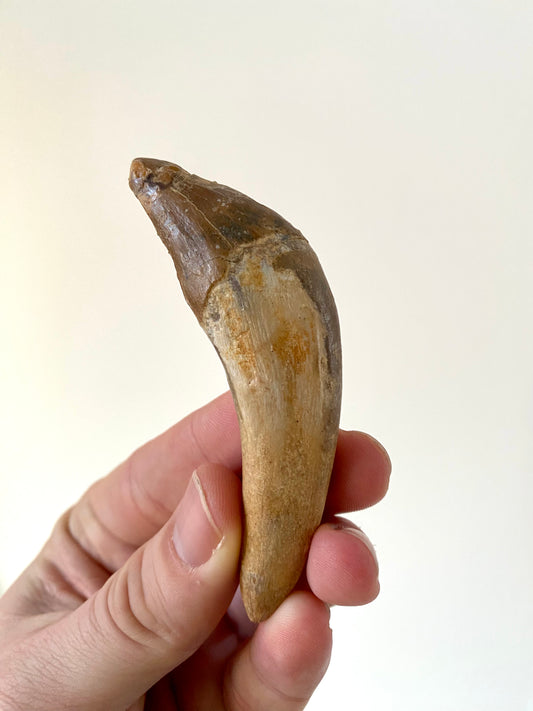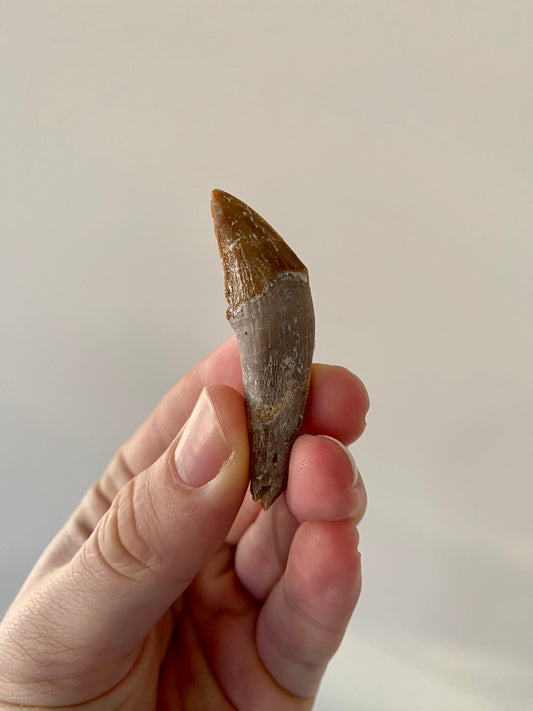Collection: Basilosaurus – The Ancient Whale of the Eocene
Basilosaurus lived during the Eocene (40–34 million years ago) and is regarded as one of the first fully aquatic whales. Reaching lengths of up to 18 meters, it was an apex predator inhabiting the warm seas of what is now North Africa and North America. Despite its name (“king lizard”), Basilosaurus was not a reptile but an early whale.
Our Basilosaurus fossil collection features teeth that provide tangible evidence of this iconic marine mammal.
-
Basilosaurus fossil tooth (2.34") - Late Eocene, Morocco
Regular price €65,00 EURRegular priceUnit price / per -
Basilosaurus fossil tooth (3.04") - Late Eocene, Morocco
Regular price €70,00 EURRegular priceUnit price / per -
Basilosaurus fossil tooth (3.33") - Late Eocene, Morocco
Regular price €80,00 EURRegular priceUnit price / per -
Large Basilosaurus fossil tooth (4.95") - Late Eocene, Morocco
Regular price €130,00 EURRegular priceUnit price / per -
Basilosaurus fossil tooth (3.48") - Late Eocene, Morocco
Regular price €95,00 EURRegular priceUnit price / per -
Basilosaurus fossil tooth (2.23") - Late Eocene, Morocco
Regular price €75,00 EURRegular priceUnit price / per
About Basilosaurus
Basilosaurus is an intriguing genus of prehistoric whale that lived during the Eocene epoch, approximately 40 to 34 million years ago. Despite its name, Basilosaurus is not actually a reptile; rather, it is a fully aquatic mammal and one of the earliest known members of the order Cetacea, which includes modern whales, dolphins, and porpoises.
Physical Characteristics:
Basilosaurus was a formidable predator, reaching lengths of up to 50 to 60 feet (15 to 18 meters) and possessing a streamlined body adapted for life in the water. Unlike modern whales, Basilosaurus had elongated bodies with serpentine-like features, earning them the nickname "Zeuglodon" (meaning "yoke-toothed") due to their unique tooth structure. Their long, slender bodies were equipped with powerful flippers and a tail fluke, enabling efficient swimming and maneuverability in the ancient seas.
Skull and Dentition:
The skull of Basilosaurus was elongated and equipped with sharp teeth, particularly in the anterior portion of the jaws. These teeth were conical in shape and well-suited for grasping and tearing prey. Basilosaurus likely preyed on a variety of marine organisms, including fish, smaller marine mammals, and cephalopods. The dental formula of Basilosaurus included sharp, pointed teeth, which were indicative of its carnivorous diet and predatory lifestyle.
Habitat and Distribution:
Basilosaurus inhabited ancient oceans worldwide, with fossil specimens discovered in various regions, including North America, Africa, and the Middle East. These marine mammals thrived in warm, shallow seas that were abundant with marine life during the Eocene epoch. Basilosaurus likely occupied a niche as apex predators within these ancient ecosystems, playing a crucial role in regulating marine food webs and ecosystem dynamics.
Evolutionary Significance:
Basilosaurus occupies a significant place in the evolutionary history of whales, representing an intermediate stage between early terrestrial ancestors and modern cetaceans. Its fossilized remains provide important insights into the transition from land to sea in cetacean evolution, shedding light on the anatomical adaptations and ecological adaptations that accompanied this evolutionary shift. Basilosaurus, along with other early whales, played a key role in the development of marine mammal diversity and the colonization of the world's oceans.
Extinction:
Basilosaurus and other members of its lineage eventually went extinct by the end of the Eocene epoch, as global environmental conditions underwent significant changes. Factors such as shifts in oceanic circulation, alterations in marine productivity, and the onset of cooling climates may have contributed to the decline and eventual extinction of Basilosaurus and its relatives. Despite their disappearance from the fossil record, Basilosaurus remains an iconic symbol of ancient marine life and the evolutionary history of whales.
Basilosaurus – The Ancient Whale of the Eocene


